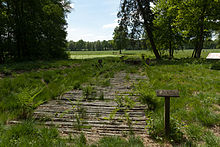Bog archeology

The peat archeology is a specialized field of archeology . It deals with the research of living things, including people, tools and equipment that have been preserved in raised bogs over centuries and millennia.
Development history
The beginning of the raised bog growth is the consequence of the continuous post-glacial climate change, during which the annual average temperature and the amount of precipitation rose significantly to an average of over 700 mm. Both factors made a decisive contribution to the formation of swamp areas and the formation of fens at suitable locations. They were the germ cells of the raised bogs that grew up in the Atlantic (from around 7000 BC) and that subsequently covered larger regions of the north German lowlands . In the 18th century the bog share in many areas was more than 30% of the total area.
Usage history
The raised bogs remained largely untouched until the 19th century. Attempts to start the cultivation of the wasteland from the moor edges failed due to a lack of concepts and sufficient government support. In the second half of the 19th century, the superficial cultivation of the bog in connection with effective drainage for the cultivation of crops and as pasture for cattle was tackled with greater success. At the same time, scientific research into peat began, particularly with a view to expanding its potential uses. After initially only the lower peat layer (black peat) was removed by hand as burning peat, the processing of the younger raised peat layers (white peat) into fertilizer and scattered peat began in the first half of the 20th century. The dismantling was done mechanically. By creating new sales markets and expanding the product range, the peat industry has meanwhile become an important economic factor, and there is still great interest in other mining areas. Agriculture and forestry have also made a major contribution to the transformation of the moorland through lowering the groundwater level or through subsequent use.
Research history
Peatland archeology has a tradition of over 200 years in northwest Germany . The first public discussion arose after a press report in 1791 in Oldenburg, when the discovery of a female bog corpse was reported. In 1812 the Lohner historian and politician Carl Heinrich Nieberding published reports on "newly discovered old military routes through the moor near Lohne" on the basis of the investigations he carried out on boardwalks in the Great Moor . In 1888, the Oldenburg museum director Friedrich Kurt von Alten announced the results of his investigations on plank paths in the Grand Duchy of Oldenburg . At the end of the 19th century, the director of the Osnabrück grammar school Friedrich Knoke and the headmaster Franz Böcker from Dammer researched Bohlenwege. During this time, the district building inspector Hugo Prejawa from Diepholz emerged as a pioneer in mapping moorland trails . In the 20th century, scientists of moor archeology, such as Ernst Sprockhoff , took on. After the Second World War, Hajo Hayen continued moor archaeological research as an employee of the State Museum for Natural History and Prehistory .
Moore as a historical archive
An intact moor has the special ability to permanently preserve archaeological finds made of organogenic substances such as wood, skin, fabric, fur or the like. Such objects in particular are an excellent addition to the portfolio of mineral floors, in which they perish under normal circumstances.
For moor archeology, the high moor areas of Lower Saxony represent a first-rate cultural archive. Wherever their destruction continues unstoppably, it is particularly important to collect information through targeted investigations, evaluate it and bring it into historical context.
One research area is the moor-archaeological land survey ( moor cadastre ). In addition, the development of the respective moors is being researched as part of a prophylactic monument preservation. The aim is to explore the landscape - with vegetation, animal world, climate and human influence - with regard to the natural potential of this habitat in prehistory and early history .
The traces left in the moors are valuable sources of information:
- Bog corpses on the state of health, diet, personal hygiene, hair and beard dress of earlier cultures
- Cult figures such as Braak's pair of gods and offerings are evidence of spiritual and religious imaginations
- Clothing such as the Uetersen Bundschuh , gorgeous coats , smocks and trousers for fashion
- Everyday tools such as the Walle plow testify to the manual and technical skills of our ancestors
- Bog trails as a result of organized planning provide information about social structures
See also
literature
- Hajo Hayen : Moore as a source of history. Possibilities and demands of moor archeology. Negotiations German Commissioner for Nature Conservation and Landscape Management, Volume 18, 1968.
- Mamoun Fansa (Ed.) U. Hajo Hayen (Illustrator): Bog archeology in Northwest Europe. Commemorative letter for Dr. hc Hajo Hayen. (Archaeological Communications from Northwest Germany 1992, 15), Isensee, Oldenburg 1992, ISBN 389442141X ; 200 p.m. Fig.
- Hans-Georg Kempfert, Berhane Gebreselassie: Excavations and Foundations in soft soils . Springer 2015 ISBN 978-3-540-32894-0
Web links
- Moor archeology at the Lower Saxony State Office for Monument Preservation
- Selected literature on Lower Saxony moor archeology ( Memento from October 9, 2007 in the Internet Archive ) (PDF file; 34 kB)
- Bog archeology in the Lohne Industrial Museum ( memorial from September 22, 2005 in the Internet Archive )
- Bog archeology I
- Bog archeology II
- Moor archeology at the moor and fen museum Elisabethfehn
- Somerset engl.